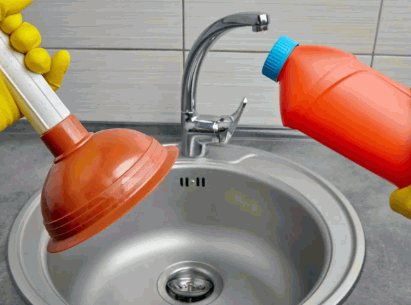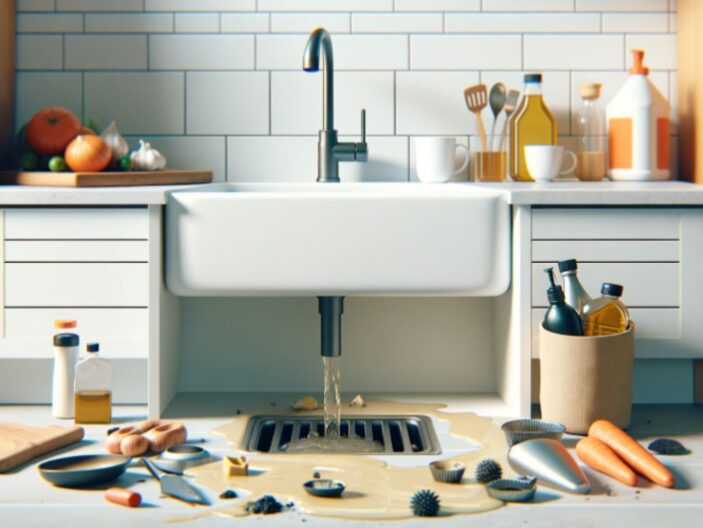A blocked sink drain can be a frustrating and messy problem, but understanding its causes and solutions can make all the difference, especially when considering effective methods to unclog your sink.
From grease buildup to stubborn hair clogs, various factors can lead to drainage issues.
This guide covers common culprits, effective prevention strategies, and the tools needed to tackle a blockage, including various cleaning supplies and techniques.
Additionally, it provides a step-by-step approach to unblocking your sink and advice on when to call in a professional.
Say goodbye to sink troubles!
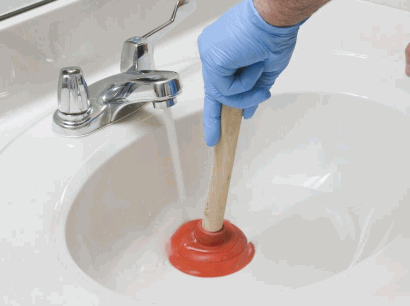
What Causes A Blocked Sink Drain?
Blocked sink drains are a common household issue that can arise from various sources, leading to frustrating situations where water cannot flow freely, causing clogs that disrupt daily activities. Causes of blocked drains often include the buildup of grease, oil, and food residues that accumulate over time, as well as hair clumps that get trapped. Additionally, foreign objects and debris can exacerbate the problem, resulting in severe clogs that require immediate attention and might necessitate the assistance of a professional plumber. Understanding these causes is essential for effective prevention and maintenance, especially as neglected drains can lead to costly plumbing repairs and health hazards, emphasizing the need for regular cleaning and inspection of your pipes.
Delve into: How To Keep Drain Pipes Clean
Grease And Oil Buildup
Grease and oil buildup is a leading cause of clogs in sink drains, especially in kitchens where cooking oils are frequently used.
Over time, the residues from these substances can accumulate within the pipes, forming a hardened layer that narrows the passage and ultimately leads to blockages. Understanding how grease hardens is essential for homeowners to prevent this common issue. This hardening occurs as fats cool and solidify, turning into a sticky mass that attracts other debris. Consequently, on a regular basis, fibrous materials, scraps of food, and soap can adhere to these grease deposits, worsening the situation.
- To avoid these issues, it is crucial to dispose of cooking fats properly.
- Regularly flushing the drains with hot water and vinegar can help dissolve smaller buildups.
- Using sink strainers can also prevent food waste from entering the pipes in the first place.
Taking these preventive measures can significantly reduce the risk of clogs and keep your drains flowing smoothly, ensuring that you avoid the hassle of plumbing emergencies.
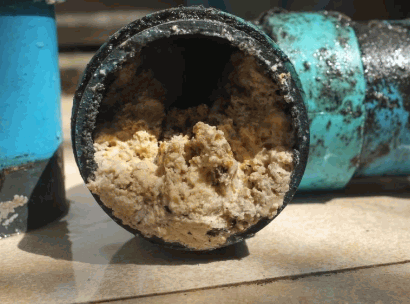
Food Debris
Food debris is another significant contributor to blocked sink drains, often accumulating after meals and improperly disposed waste, leading to potential overflows and unpleasant odors. When food particles combine with grease, they can create a sticky residue that adheres to the walls of the pipes, leading to severe clogs over time.
This build-up not only slows drainage but can also produce unpleasant odors. To combat this issue, it’s essential to implement effective disposal techniques, such as utilizing a garbage disposal unit and proper methods for disposing of fats and oils. Consider the following tips to keep your sink and drain in optimal condition:
- Always scrape excess food into the trash rather than rinsing it down the sink.
- Use a sink strainer to catch smaller debris before it has a chance to enter the drain.
- Occasionally flush the drain with hot water to help break down any lingering fats.
- Avoid pouring oils or fats directly into the sink, as they can solidify and cause blockages.
By adopting these practices, one can significantly reduce the risk of clogs, ensuring smooth drainage and a cleaner kitchen environment.
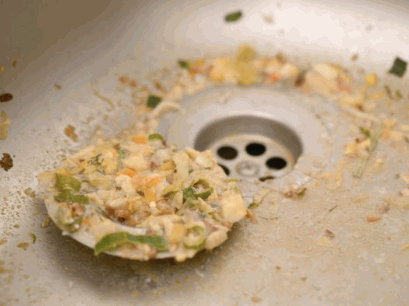
Hair And Soap Scum
Hair and soap scum are troublesome culprits in bathroom sinks, often leading to clogged drains that can disrupt daily routines.
Over time, loose strands of hair can intertwine with soap scum, creating a thick sludge that effectively obstructs water flow through the plumbing system. This combination not only accumulates in the trap but can also bind together, making it increasingly difficult for water to pass. Neglecting this issue can ultimately result in a blocked drain, which may necessitate costly professional intervention.
To mitigate these concerns, it’s advisable to implement some preventive measures, including using stoppers to prevent hair from entering the drain.
- Regularly clean hair and debris from sink surfaces.
- Consider using stoppers or drain catchers to trap hair before it enters the plumbing.
- Occasionally flush the drain with hot water to help dissolve soap scum.
Adopting these simple practices can significantly enhance the longevity and functionality of your bathroom sink.
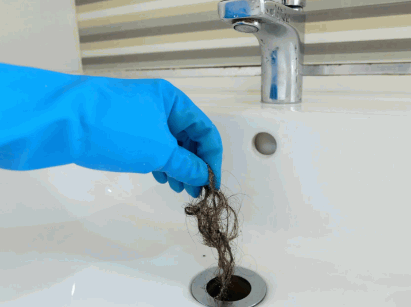
Mineral Buildup
Mineral buildup, particularly in areas with hard water, can significantly contribute to sink drain blockages and require special attention.
Over time, these minerals accumulate and coat the insides of pipes, gradually narrowing the passage and making it crucial to regularly clean the pipes. As the diameter of the pipes decreases, water flow is hindered, which can ultimately lead to frustrating clogs. Plus causing water to drain slowly, this buildup can create an environment where bacteria thrive, further exacerbating hygiene issues.
To mitigate this problem, it’s essential to:
- Regularly clean drain pipes with appropriate cleaning solutions.
- Consider using a water softener to reduce mineral content in hard water.
- Schedule routine plumbing inspections to catch early signs of buildup.
By staying proactive and implementing these strategies, homeowners can keep their sink and drain systems in optimal condition.
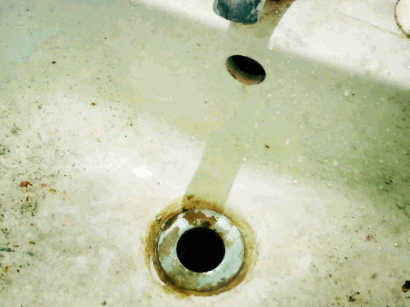
How To Prevent A Blocked Sink Drain?
Preventing a blocked sink drain is crucial for maintaining a smoothly operating plumbing system and can save homeowners from costly repairs down the line. Implementing simple methods such as regular cleaning and using tools can significantly minimize the risk of clogs. By making informed choices about what goes down your sink and utilizing effective cleaning techniques, such as baking soda and vinegar, you can ensure that water flows freely and efficiently, preventing the buildup of debris and other materials that lead to blockages.
Use A Sink Strainer
Using a sink strainer is an effective way to prevent unwanted debris from entering your drain and causing blockages.
In fact, these handy devices serve as the first line of defense in your kitchen or bathroom plumbing system. They act like a shield, effortlessly trapping food particles, hair, and other small debris that could lead to more significant plumbing issues over time.
When utilized correctly, a strainer not only helps maintain a clear drain but also reduces the need for frequent plumbing repairs, saving both time and money.
Regularly cleaning the strainer is essential, as this simple act ensures that it remains efficient in capturing debris, promoting a healthier plumbing environment.
By prioritizing such preventive measures, anyone can enhance the longevity and functionality of their drainage system.
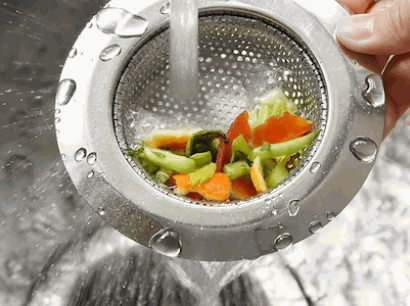
Dispose Of Grease Properly
Properly disposing of grease is essential in preventing clogs in your sink drain, as pouring it down the drain can lead to hardened buildup.
When grease cools, it transforms into a solid mass that can significantly obstruct the flow of water, leading to severe plumbing issues and expensive repairs. Instead of taking the easy route and tossing it into the sink, consider these eco-friendly alternatives:
- Let it cool: Allow the grease to cool in a container, then dispose of it in the trash.
- Reuse it: If you’re cooking again soon, some greases can be salvaged for future frying.
- Composting: Small amounts of animal fat can sometimes be added to a compost pile, aiding in decomposition.
Taking these steps not only helps protect your plumbing but also positively impacts the environment by reducing waste.
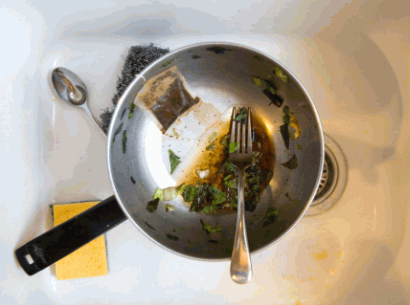
Run Hot Water After Use
Running hot water down your sink after each use can help dissolve potential buildups and prevent blockages in the drain.
This simple yet effective practice not only facilitates the breakdown of lingering grease and food residues but also serves to maintain the overall health of your plumbing system, reducing the need for chemical cleaners and professional interventions. By ensuring that hot water flows through the drain regularly, unwanted substances are less likely to gather over time. Consider the following benefits:
- Prevents blockages: Regularly flushing your sink with hot water ensures that any remaining remnants of food or fats are eliminated, significantly reducing the chance of future clogs.
- Cleans pipes: Hot water can reach deep into the crevices of your plumbing, helping to dislodge stubborn residues that could cause problems later.
- Improves hygiene: Keeping the drain clean not only helps with functionality but also prevents odors, contributing to a fresher kitchen environment.
Taking a few moments to run hot water after cleaning dishes or preparing meals can go a long way in keeping your sink and drain in top shape.
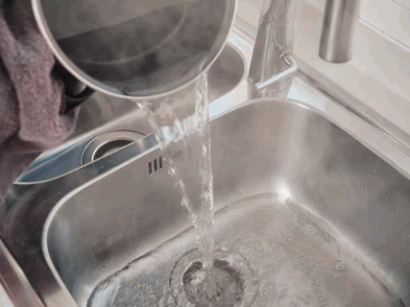
Regularly Clean The Drain
Regularly cleaning your drain is a key practice in maintaining a clear sink and avoiding potential blockages, which can lead to costly plumbing repairs if ignored.
By ensuring that debris and buildup are promptly dealt with, you can save yourself from the inconvenience and cost of unexpected plumbing issues. There are several effective cleaning methods that can be easily incorporated into your routine maintenance, including using a plunger and a drain cleaner for tough clogs.
- One popular method is using baking soda and vinegar; this duo not only aids in breaking down grime but also neutralizes odors.
- Another technique includes regularly flushing the drain with hot water, which helps dissolve any lingering substances.
- Using a drain strainer can catch food particles and hair, drastically reducing the chances of clogs.
Prioritizing these simple yet effective practices not only keeps your sink functioning smoothly but also promotes a healthier home environment.
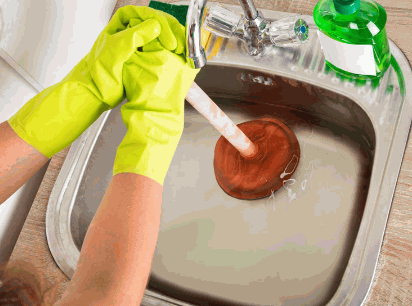
Tools And Materials Needed To Unblock A Sink Drain, Including Liquid-Plumr® And Augers
To effectively unblock a sink drain, having the right tools and materials on hand is essential for any homeowner or DIY enthusiast. Common items include a plunger, drain snake, and household ingredients like baking soda and vinegar that can aid in clog removal. Additionally, knowing how to utilize these tools and understanding when to call a professional can make a significant difference in maintaining a functional plumbing system, ensuring that water flows freely and without hassle.
Plunger
A plunger is a fundamental tool for unblocking sink drains, utilizing suction to dislodge clogs effectively.
When faced with a stubborn blockage, using it can be a simplified solution that often produces immediate results. Understanding how to maneuver the tool across different types of clogs is crucial.
- For clogged sinks, ensure a proper seal by covering the overflow hole.
- In bathtubs, angle the plunger to create suction beneath the drain.
- In toilets, use a flange plunger for maximum efficiency.
To successfully unblock a drain, a series of firm thrusts can help release trapped debris, restoring normal water flow. It’s a practical method that can save both time and money when dealing with plumbing issues.
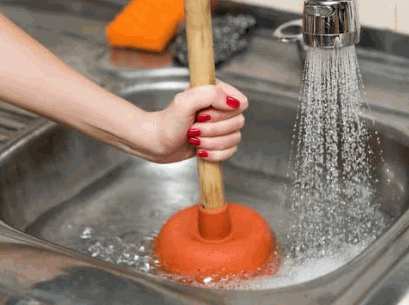
Drain Snake
A drain snake is an invaluable tool for reaching deep clogs and removing stubborn debris that a plunger may not be able to dislodge, proving essential for any homeowner or maintenance worker who encounters plumbing issues regularly.
To effectively operate a drain snake, start by gathering the necessary tools: a drain snake, a bucket to catch any debris, and protective gloves. Begin by inserting the snake’s flexible tip into the drain slowly, allowing it to navigate through the pipes. As you push forward, you may encounter resistance from the blockage.
Here are some tips for successful use:
- Ensure you have a firm grip on the handle while rotating the snake clockwise. This motion helps anchor it against the clog.
- If you feel it snag on something, gently pull back, allowing it to grip the obstruction before pushing forward again.
- Watch the debris that comes out; this can give clues about the nature of the blockage.
- Flush the line with hot water after clearing the clog to help remove any remaining residue and maintain flow.
Utilizing a drain snake not only clears clogs but also prevents future blockages, making it a handy skill to master.
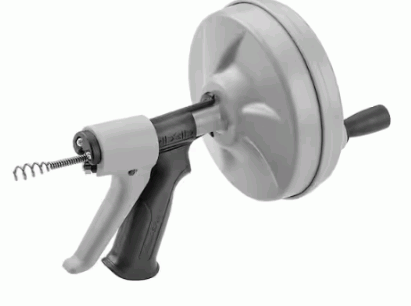
Baking Soda And Vinegar
Baking soda and vinegar serve as a powerful natural cleaner for unclogging sink drains, leveraging a chemical reaction to break down debris.
By utilizing these common household ingredients, one can create an effective solution for maintaining drain health. The process begins with measuring out approximately half a cup of baking soda. It’s crucial to pour it directly into the affected drain, allowing it to settle and begin interacting with any built-up gunk. Next, follow with a half cup of vinegar, which initiates a fizzy reaction that penetrates clogs efficiently.
- Allow this mixture to sit for at least 30 minutes.
- After the waiting period, flush the drain with hot water to help wash away the loosened debris.
This simple, yet effective method demonstrates how a natural cleaner can tackle stubborn clogs without harmful chemicals, promoting a healthier environment in your home.
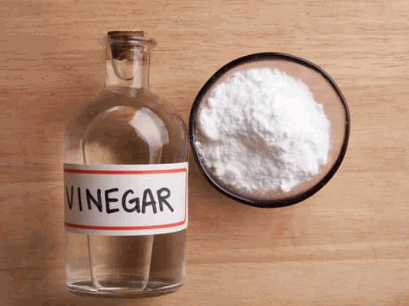
Boiling Water
Pouring boiling water down the drain can effectively dissolve grease and other buildup, making it a simple yet effective method for unclogging sinks.
When tackling stubborn blockages, relying solely on boiling water may not yield the desired results. Instead, combining this method with other techniques can significantly enhance effectiveness. For instance, unblocking the sink could be more successful when you:
- Use a plunger after pouring boiling water to further dislodge any remaining debris.
- Apply a mixture of baking soda and vinegar before the hot water to create a chemical reaction that helps break down fat and build-up.
- Utilize a drain snake to physically remove clogs that hot water may not reach.
Taking a multi-faceted approach can lead to a clearer drain and a more efficient plumbing system overall.
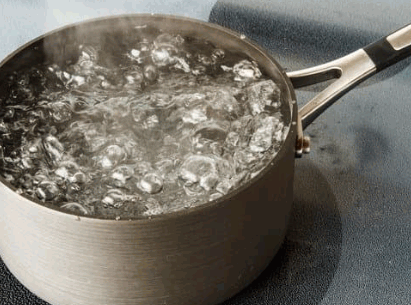
Step By Step Guide On How To Unblock A Sink Drain
Unblocking a sink drain can be a straightforward process if you follow a series of systematic steps designed to address various types of clogs. From removing standing water to utilizing tools like plungers and drain snakes, each step plays a crucial role in restoring proper water flow. This guide will provide you with a comprehensive approach, ensuring you have the knowledge to effectively tackle blockages using both DIY methods and commercial products, when necessary.
Remove Standing Water
The first step in unblocking a sink drain is to carefully remove any standing water to access the clog directly.
To effectively manage this issue, one might consider using a shallow container or bucket to scoop out the water.
Depending on the severity of the blockage, using a wet/dry vacuum can be a great option as it quickly removes larger volumes of water from the sink. If there’s only a small amount of standing water, a simple cup or large measuring cup might suffice.
After removing the water, it’s crucial to inspect the drain for visible debris or clogs that could be causing the blockage.
Once water is cleared, it becomes easier to use methods like plunging or employing a drain snake for more stubborn clogs, ensuring that the drain flows smoothly once more.
Use A Plunger
Using a plunger is a straightforward and effective technique for dislodging clogs in sink drains, especially for minor blockages.
To achieve the best results, one must correctly utilize the plunger in a systematic manner.
Begin by ensuring the sink is filled with enough water to cover the plunger’s cup. This allows for a better seal when plunging.
Next, position the plunger over the drain and push down firmly, creating a vacuum seal, before pulling up with an equally steady force.
Repeat this action several times, ensuring that the water in the sink begins to drain smoothly.
If the clog persists, it’s advisable to check for deeper blockages and consider using other methods.
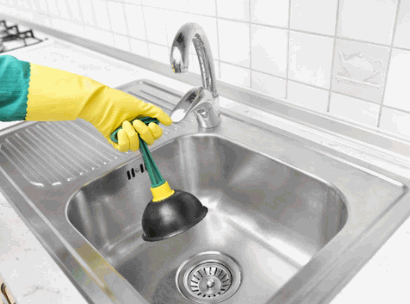
Try A Drain Snake
If the plunger doesn’t clear the blockage, trying a drain snake can help reach deeper clogs that require more forceful removal.
Using a drain snake effectively involves several straightforward steps.
- First, ensure you have the right type for your particular sink; there are various designs suited for different plumbing scenarios.
- Next, gently insert the snake into the drain, allowing it to feed through the pipes.
- As it encounters resistance, twist the handle to engage the coils, which can latch onto debris.
- To unblock the sink, pull back while rotating, snagging the clog.
- Always remember to clean the snake thoroughly after use to prevent any build-up.
Following these methods can turn a challenging plumbing task into a manageable one.
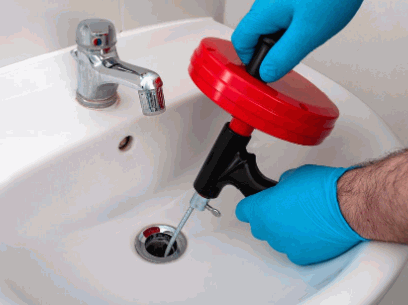
Use Baking Soda And Vinegar
After mechanical methods, using a combination of baking soda and vinegar can be an excellent natural solution to further clear any remaining debris and odors in the sink drain.
This method not only helps in maintaining a fresh-smelling kitchen but also promotes a healthier environment by avoiding harsh chemicals. To effectively use these ingredients, follow these simple steps:
- Preparation: Start by ensuring the sink is empty of any standing water and remove any visible debris.
- Application: Pour about half a cup of baking soda directly into the drain, allowing it to settle for a minute.
- Activation: Next, slowly add half a cup of vinegar, which will create a fizzing action that helps break down the buildup.
- Wait: Let the mixture sit for 15-30 minutes for the best results, as this allows the ingredients to work their magic.
- Rinse: Flush the drain with hot water to wash away remnants and odors.
By following these steps, anyone can maintain a smoother-running, odor-free sink drain with minimal effort.
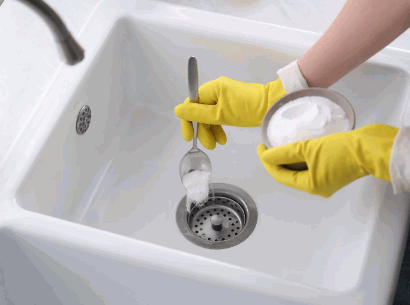
Pour Boiling Water Down The Drain
Pouring boiling water down the drain can help dissolve and flush away stubborn clogs, especially those caused by grease and soap scum.
This method is simple yet effective, particularly when dealing with kitchen sinks where food remnants and oils tend to build up. To use this technique properly, follow these steps:
- Start by boiling a kettle or pot of water until it reaches a rolling boil.
- Once boiling, carefully pour the water directly into the drain in a steady stream.
- Allow the hot water to work for a few minutes; this will soften and break down any accumulation.
It’s most effective for minor clogs; however, for more severe blockages, additional methods or tools might be necessary. Remember, this technique is not suitable for all types of drains, especially when dealing with PVC pipes that might warp from intense heat.
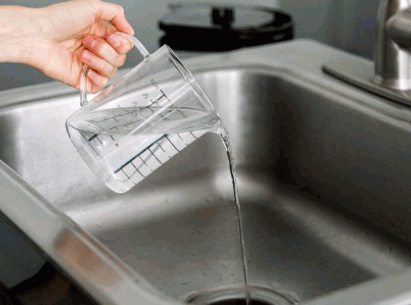
When To Call A Professional Plumber?
Knowing when to call a professional plumber is crucial in managing persistent sink drain issues that cannot be resolved through DIY methods.
Recognizing the right moment for expert assistance can save time, money, and potential damage to your home. Signs that indicate the necessity for a professional might include frequent clogs that require repeated plunging, unusual noises emanating from the sink or its pipes, and unpleasant odors that linger despite regular cleaning.
If there is visible water pooling around the sink or if the water drains significantly slower than usual, these are also signals that a professional plumber may need to get involved.
- Recurring clogs that won’t go away
- Strange sounds from the plumbing system
- Persistent foul smells
- Visible leaks or pooling around the sink
- Slow drainage despite cleaning efforts
Each of these issues can indicate deeper problems with the drain system that a skilled technician can diagnose and repair effectively.
Tips For Maintaining A Clear Sink Drain
Maintaining a clear sink drain is essential for ensuring efficient water flow and preventing future clogs, and it can be easily achieved with a few proactive tips. Regular maintenance, appropriate disposal of waste, and the use of preventive measures can significantly reduce the risk of blockages, saving both time and money in the long run. By understanding the importance of these practices, homeowners can keep their drains clear and functional.
